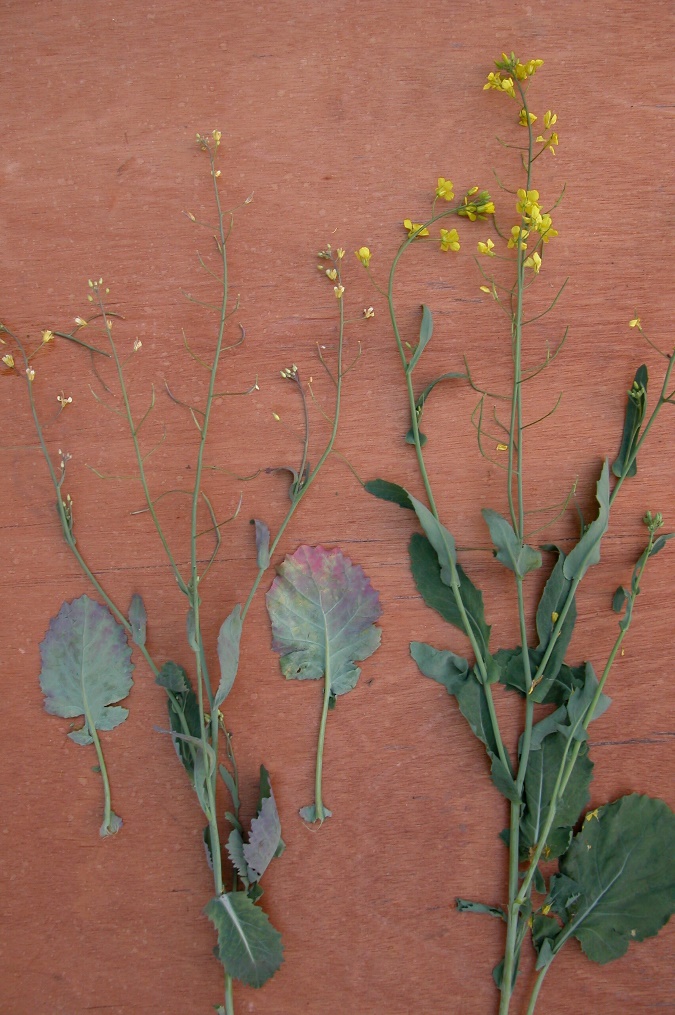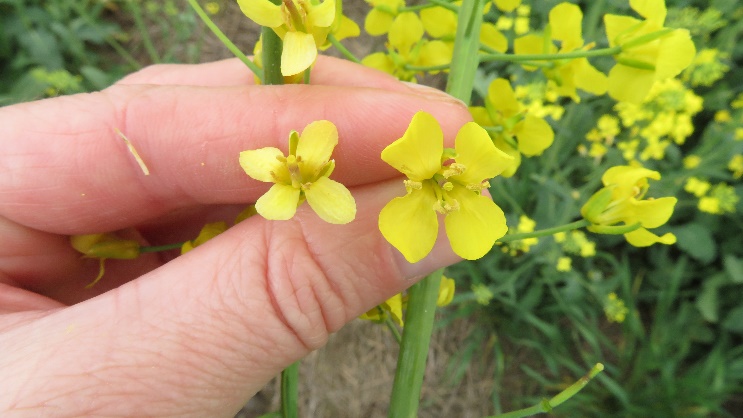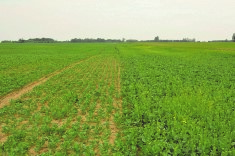Most fertilizer for spring canola in Ontario is broadcast prior to planting. The high rates of nitrogen and sulphur required, as well as the seeding methods used, make it inconvenient and risky to apply fertilizer with the seed. Some Ontario producers split-apply nitrogen to improve nitrogen use efficiency by applying the second pass when canola is rapidly taking up nitrogen, and to tailor the nitrogen rate to the weather conditions and perceived yield potential. Many Ontario producers apply low rates of phosphorous with the seed.
Maximum Safe Rates of Seed-Placed Nutrients
Up to 28 kg/ha (25 lb/acre) of phosphate (P205) may be seed-placed as ammoniated phosphate, or as superphosphate or MAP. Ensure the rate of nitrogen placed with the seed does not exceed 11 kg/ha (10 lb/acre).
The rate of nitrogen, potash (K2O) and sulphur placed with the seed must not exceed 11–33 kg/ha (10–30 lb/acre) depending on soil type. The lower rate is applicable on sandy loam soils.
Ammonium sulphate has a high salt index and rates above 22 kg S/ha (20 lb S/acre) can reduce emergence, especially in dry conditions.
Nitrogen Rates
Canola has a great demand for nitrogen (N). Previous recommendations for Ontario producers based on a price ratio of nitrogen cost to grain price are now outdated, and limited research has been conducted in recent years. The results of one study conducted from 2018 to 2022 in Ottawa recommend 140 kg N/ha (125 lb N/ac) for Ontario canola1. This rate aligns with common practices in Ontario and is supported by uptake and removal guidelines for canola in Western Canada that were updated in 2023. The uptake guidelines state that canola requires an average of 47.6 kg N/MT (2.38 lb N/bu), so 139 kg N/ha (124 lbs/acre) is required for a crop yielding 2919 kg/ha (52 bu/ac or 1.18 tonne/ac), which is a typical yield goal in Ontario. Producers looking for information on the most economic rate of nitrogen for canola can consult the Manitoba Agriculture Nitrogen Rate Calculator, but should note that this was developed based on data generated in 1989 to 2004 in Western Canada.
Adjust rates downward if manure was applied or if the previous crop contained legumes such as alfalfa. Table 9–9, Adjustment of nitrogen requirement where crops containing legumes are plowed down and Table 9–10, Typical amounts of total and available nitrogen, phosphate and potash from various organic nutrient sources and average concentrations. Excessive nitrogen on canola has been linked to increased incidence of green seed and can also increase the number of days to maturity.
Nitrogen Placement and Timing
Nitrogen should not be placed with the seed. Seedlings are sensitive to ammonia toxicity and the salt effect of fertilizers that causes desiccation of seedlings. Nitrogen fertilizer is typically broadcast in canola in the spring, but where equipment allows can be banded 5–7.5 cm (2–3 in.) to the side of the seed row.
Split applications of nitrogen (N) may increase yield compared to equivalent nitrogen rates applied pre-plant. In research conducted in Ottawa in 2011 to 2013, applying 50 kg N/ha pre-plant followed by 50 or 100 kg N/ha at the 6-leaf stage improved yield by up to 16% compared to the equivalent pre-plant only applications2. In a similar study conducted in 2018 to 2022, split applications did not significantly improve yield compared to preplant applications, although yield of the split-N method was numerically similar or slightly higher than preplant only applications1. Split-applying nitrogen offers an opportunity to adjust nitrogen rates based on yield potential or environmental conditions and may improve nitrogen use efficiency. A 19% increase in yield with split N applications was observed in Ottawa in 2021, with normal and well-distributed rainfall and air temperatures 3°C below normal during flowering. However, in the same study conducted in Melfort, Saskatchewan, a decrease in yield was observed with split applied nitrogen when there was a moderate drought stress following the second nitrogen application in 2022. In Ontario, producers who are split-applying nitrogen are commonly applying around 80 kg N/ha (71 lb N/ac) in the first pass, whereas 50 kg N/ha (45 lb N/ha) was applied preplant in the studies referenced above.
The maximum rates of nitrogen uptake occur during bolting through to mid-bloom. While applications during early bloom may benefit the canola crop, the most economical application timing for top dressing nitrogen is prior to bolting. This means that when split applying nitrogen the second application may occur just a few weeks after canola emergence, which may be inconvenient or difficult to achieve during the busy spring season.
There is some risk of injury with top dressing high rates of nitrogen, but in-crop applications can be safely applied by broadcasting dry (urea) products or dribble banding liquid (UAN) products. Granular products should be applied when leaves are dry, while liquid products should be applied when leaves are moist, to reduce the potential of fertilizer sitting on leaves. Liquid products may cause some burn or stress so herbicides should not be applied for a few days after fertilizer application.
Nitrogen deficiency appears as premature yellowing of the older, lower leaves. Deficient plants may appear spindly and thin and have an overall pale or yellow colour. In some cases, leaves may have a range of colours including yellow, orange and purple on lower leaves. Healthy leaves are a dark blue-green colour.
Sulphur
Canola has a much higher requirement for sulphur (S) than most other field crops grown in Ontario. Sulphur levels can be variable across a field, and sulphur is mobile in the soil. It is critical to apply sulphate to avoid deficiencies. A deficiency can occur at any crop stage and can reduce yields. The current guideline is to apply a minimum of 22.5 kg/ha (20 lb/acre) of sulphate pre-plant. According to the recently updated guidelines on nutrient uptake and removal in Western Canada, canola requires 16.6 kg S/MT (0.86 lb S/bu) so an average Ontario crop yielding 2964 kg/ha (52 bu/ac or 1.2 tonne/ac) requires 49 kg S/ha (44 lb S/ac). While some sulphur will be supplied by the soil, annual application of sulphur is recommended. Complete conversion of elemental sulphur to the usable sulphate form can take 2 to 3 years so application of elemental sulphur in spring or the previous fall are unlikely to be available in time to meet crop needs.
Sulphur is linked to soil organic matter and is mobile, like nitrogen. Sulphur deficiency is more likely to occur on sandy or open bottom soils with low organic matter. It is possible to correct an observed deficiency with a broadcast application of sulphur. Ideally sulphur should be applied by the 6-leaf stage of the crop, when demands begin to increase rapidly. However, applications up to the early flowering stage may provide a yield benefit where deficiencies exist. Effective absorption of sulphur occurs when foliar applications are made during the evening or early morning when temperatures are moderate, and under high humidity conditions.
Sulphur deficiency may appear as yellowing and upward cupping of new leaves. These symptoms are often accompanied by purple colouring at leaf edges or on the back of the leaf due to anthocyanin pigments caused by sugar buildup resulting from the deficiency (Figure 1). Sulphur deficiency in the seedling stage is typically only observed if the deficiency is severe. During flowering stages, deficient plants have small, pale flowers (Figure 2). If deficiency occurs during later growth stages, plants may display symptomatic flowers but leaves may not show symptoms.

Figure 1. Sulphur deficiency (left) results in mottling of the leaf surface, purple underside of leaves and small, pale-yellow flowers.

Figure 2. Sulphur deficient plants observed during bloom stages may not express symptoms on leaves but may have smaller, pale flowers (left).
Phosphate and Potassium
Phosphate and potassium recommendations for canola are based on OMAFA-accredited soil tests, as provided in Tables 1 and 2. The phosphorus requirements of canola are greater than for cereals, due to the higher protein content of the seed. The nutrient uptake and removal guidelines for Western Canada indicate an average of 18 kg P/MT (0.90 lb P/bu) is taken up by the crop and 13.4 kg P/MT (0.67 lb P/bu) is removed in the grain. Although canola is responsive to starter phosphorous it is also sensitive to salt injury. Refer to Table 9–22, Chapter 9, Maximum safe rates of nutrients in fertilizer.
Canola requires 50 kg K/MT (2.5 lb K/bu) per bushel. Most potassium remains in the plant biomass and is returned to the soil. Yield response to potassium is expected on soils with less than 100 ppm (Table 2).
Table 1. Phosphate guidelines for canola
| Sodium Bicarbonate Phosphorus Soil Test | Phosphate Required |
| 0–3 ppm | 70 kg/ha (HR) |
| 4–5 ppm | 60 kg/ha (HR) |
| 6–7 ppm | 50 kg/ha (HR) |
| 8–9 ppm | 30 kg/ha (HR) |
| 10–12 ppm | 20 kg/ha (MR) |
| 13–15 ppm | 20 kg/ha (MR) |
| 16–30 ppm | 0 (LR) |
| 31–60 ppm | 0 (RR) |
| 61 ppm + | 0 (NR)1 |
| 100 kg/ha = 90 lb/acre | |
| Legend: HR = high response MR = medium response LR = low response RR = rare response NR = no response | |
| 1 When the response rating for a nutrient is “NR,” application of phosphorus in fertilizer or manure may reduce crop yield or quality. For example, phosphorus applications may induce zinc deficiency on soils low in zinc and may increase the risk of water pollution. Based on OMAFRA-accredited soil tests. Profitable response to applied nutrients occurs when the increase in crop value, from increased yield or quality, is greater than the cost of the applied nutrient. Where manure is applied, reduce the fertilizer application according to the amount and quality of manure (Chapter 9, Manure section). | |
Table 2. Potash guidelines for canola
| Ammonium Acetate Potassium Soil Test | Potash Required |
| 0–15 ppm | 70 kg/ha (HR) |
| 16–30 ppm | 50 kg/ha (HR) |
| 31–45 ppm | 40 kg/ha (HR) |
| 46–60 ppm | 30 kg/ha (HR) |
| 61–80 ppm | 20 kg/ha (MR) |
| 81–100 ppm | 20 kg/ha (MR) |
| 101–120 ppm | 0 (LR) |
| 121–250 ppm | 0 (RR) |
| 251 ppm + | 0 (NR)1 |
| 100 kg/ha = 90 lb/acre | |
| Legend: HR = high response MR = medium response LR = low response RR = rare response NR = no response | |
| 1 When the response rating for a nutrient is “NR,” application of potash in fertilizer or manure may reduce crop yield or quality. For example, potash applications may induce magnesium deficiency on soils low in magnesium. Based on OMAFRA-accredited soil tests. Profitable response to applied nutrients occurs when the increase in crop value, from increased yield or quality, is greater than the cost of the applied nutrient. Where manure is applied, reduce the fertilizer application according to the amount and quality of manure (Chapter 9, Manure section). | |
Canola takes up phosphorus from the soil rapidly in the early growth stages and continues to remove phosphorus for up to about 8 weeks. Although canola requires a large amount of phosphorus, canola successfully scavenges phosphorous from the soil profile and maximum yields are attained at generally lower rates than that for most spring cereals. Canola is non-mycorrhizal and does not utilize fungal networks in soil to take up phosphorous. The roots of canola will proliferate extensively in banded fertilizer phosphorus.
When applying phosphorus, an adequate supply near the seed row is important for early access. When broadcast, 2–4 times more P is required to obtain the same yield response as banded P, and broadcast P is also at higher risk for runoff. Canadian research indicates that canola yields are optimized with an initial 17–22 kg/ha (15–20 lb/acre) of starter P205, even on soils with high fertility levels. Response to starter P is more likely on cold, low fertility soils, when planting early. Canola research has verified that MAP (11-52-0) is equally effective to other dry starters and liquid P fertilizer materials. The impact of starter fertilizer on early growth can be seen in Figure 3 where on a medium fertility level soil, the crop on the left side of the photo had no starter fertilizer applied, while on the right side of the photo the crop received 55 kg/ha (50 lb/acre) of MAP as a starter fertilizer at planting.

Figure 3. The impact of early canola growth is evident for this medium fertility field, where the crop on the left side had no starter fertilizer applied while the crop on the right side the crop received 55 kg/ha (50 lbs/acre) of MAP at planting.
Boron
Boron deficiencies are rare in canola. Ontario field trials with foliar boron 0.34 kg/ha (0.3 lb/acre) applied at early flower did not show a consistent economic yield response. Although rarely seen, when it occurs it can reduce yields significantly.
Symptoms can include:
- Stunted appearance
- Brown areas in pith of the stem or cracked stems
- Brown to reddish coloured new leaves and yellow to brown spots in between leaf veins
- Cupping of leaves
- Prolonged flowering and poor pollination
Boron deficiency can be corrected with either foliar or soil applications of soluble boron fertilizers. Although there is little evidence of an economic response to boron applications, soil applied pre-plant applications and addition of boron to fungicide applications are common in Ontario.
References
- Wen, G, B.L. Ma, M. St. Luce, K. Liu, P. S. Mooleki, S. Crittenden, R. Gulden, G. Semach, P. Tiege and P. Lokuruge. 2023. Optimizing nitrogen fertilization for hybrid canola (Brassica napus L.) production across Canada. Field Crops Research. 302:109048.
- Ma, B.L. and A.W. Herath. 2016. Timing and rates of nitrogen fertiliser application on seed yield, quality and nitrogen-use efficiency of canola. Crop & Pasture Science. 67(2) 167-180.